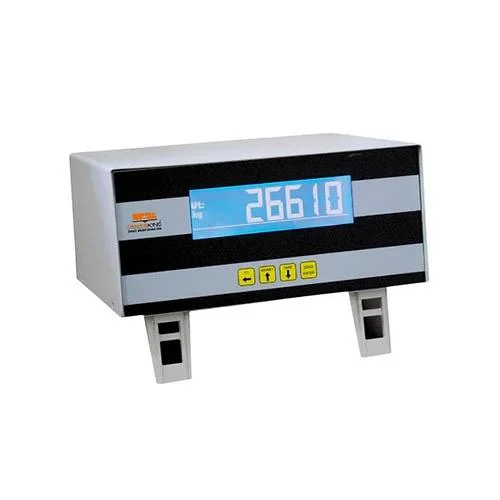The Future of Weight Indicators: Touchscreen, Cloud & AI Integration
- Kanta King

- Nov 13
- 4 min read
In an era where technology defines the pace of progress, even the simplest devices are becoming smarter — and the humble weight indicator is no exception. Once a basic numeric display unit showing weight values, it has now evolved into a powerful control center for industrial weighing operations.
Today’s weight indicators are not just about measuring weight — they’re about data intelligence, connectivity, and automation. As industries move towards digital transformation, innovations like touchscreen interfaces, cloud connectivity, and AI-powered analytics are reshaping how we perceive and use weighing systems.

Let’s explore how these advancements are setting the stage for the next generation of intelligent weighing solutions.
1. Touchscreen Interfaces: Simplifying Complex Operations
Gone are the days when operators relied on small monochrome displays and physical buttons to manage weighing data. The rise of touchscreen indicators has completely changed user experience in weighbridge and industrial environments.
Modern weight indicators feature intuitive touch-based controls, high-resolution displays, and interactive menus that make navigation effortless. Operators can quickly perform functions such as:
Taring and zeroing with a single tap
Accessing detailed transaction logs
Configuring calibration and communication settings
Printing or exporting weigh tickets instantly
These interfaces reduce training time and minimize human errors — especially in environments where multiple operators use the same system.
Moreover, touchscreen indicators support multilingual interfaces, custom icons, and even color-coded alerts, enabling operators from diverse backgrounds to work seamlessly. It’s not just about convenience — it’s about making accuracy and efficiency accessible to everyone on the shop floor.
2. Cloud Connectivity: Weighing Enters the Digital Ecosystem
As industries embrace the Internet of Things (IoT), cloud integration has become a game changer in the weighing world. Traditional standalone systems are being replaced by connected indicators that can transmit real-time data to the cloud.
Imagine a scenario where every weight reading, vehicle record, and operator activity is automatically synced to a secure online dashboard. Managers can monitor weighbridge operations from any location, analyze productivity, and even receive alerts for abnormalities — all from their smartphones or laptops.
Key benefits of cloud-connected weight indicators include:
Real-time monitoring: Access data from multiple weighing sites in one dashboard.
Centralized reporting: Generate detailed analytics for compliance and audits.
Data backup and security: No fear of data loss due to hardware failures.
Remote updates and troubleshooting: Manufacturers can push software updates or diagnose issues without visiting the site.
This level of transparency and control helps businesses move toward smart logistics, digital recordkeeping, and environmental accountability — aligning with global sustainability and traceability goals.
3. Artificial Intelligence: From Measurement to Prediction
While cloud connectivity brings visibility, AI integration brings foresight. The latest frontier in weighing technology is using Artificial Intelligence to not only record data but also interpret it.
AI-powered indicators can detect patterns, predict anomalies, and enhance decision-making. For example:
Predictive maintenance: The system can alert technicians when load cells show early signs of drift or malfunction.
Smart calibration: AI can automatically adjust calibration parameters based on usage and environmental conditions.
Fraud detection: Unusual weight patterns or operator activities can trigger security alerts, reducing chances of manipulation.
Process optimization: By analyzing long-term trends, AI helps optimize material handling, truck turnaround times, and resource utilization.
In industries like mining, logistics, agriculture, and manufacturing — where every tonne and second counts — AI brings intelligence to the most fundamental unit of trade: weight.
4. Integration with ERP and Automation Systems
The future of weight indicators also lies in system integration. Modern devices are designed to communicate seamlessly with ERP, PLC, and SCADA systems, ensuring that every weighing event becomes a part of the automated workflow.
For instance, in a factory setup, when a batch is weighed, the indicator can automatically send data to the ERP system to update stock levels, generate invoices, or trigger dispatch orders. This eliminates manual entry, improves accuracy, and saves time — making weighing an integral part of digital manufacturing.
5. The Human Element: Empowering Operators through Technology
Amid all the talk about automation and AI, one truth remains — technology should empower people, not replace them. Touchscreen interfaces, cloud dashboards, and AI assistants are making the operator’s job easier, safer, and more meaningful.
Operators no longer just record weights; they manage information, ensure fairness, and maintain trust in every transaction. With advanced tools at their fingertips, they can focus on accuracy and accountability rather than paperwork and troubleshooting.
This human-technology partnership is what truly defines the future of weighing.
6. What Lies Ahead?
The next few years will see smarter, more connected, and self-learning weight indicators that integrate effortlessly with the broader industrial ecosystem. With developments in edge computing, wireless sensors, and blockchain-based data validation, the weighing industry is entering an era of digital reliability and trust.
Soon, weight indicators may not just display a number — they’ll become the nerve center of intelligent logistics and manufacturing systems, where every kilogram is measured, verified, and optimized through data.
Conclusion
The transformation of weight indicators from simple displays to intelligent, connected systems reflects a larger shift — from manual weighing to data-driven decision-making. Touchscreen controls bring usability, cloud connectivity brings accessibility, and AI brings intelligence.
Together, they are redefining the way industries weigh, manage, and trust their measurements.
The future of weight indicators is not just about numbers — it’s about insight, transparency, and smarter operations. And in that future, every weight reading will tell a bigger story.
KANTA KING
Website: https://www.kantaking.com/
Contact Us: +91.9560915555
Email: info@kantaking.com




Comments